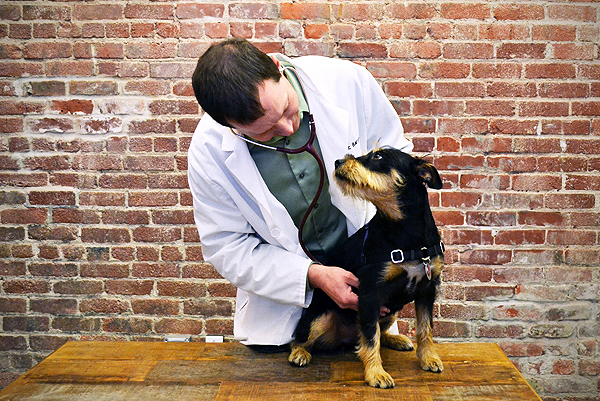Several weeks ago a concerned owner brought his exceptionally sweet terrier mix to my office. The dog was female and about 10 years old. She had suffered from vague symptoms including poor appetite and lethargy for several days, and she appeared to be losing weight. However, her behavior had changed significantly within the last 24 hours. She had begun to drink large quantities of water and she was noted to be licking her vulva excessively.
Her examination revealed a mild fever and mild dehydration (despite her increased thirst). She was slightly underweight, and she was markedly friendly. There was a small amount of crusted material on her tail, at the level of her genitals.
Her age, gender, symptoms, and exam findings were all consistent with one thing: pyometra. Pyometra occurs when bacteria enter the uterus and cause an out-of-control infection. The uterus fills with pus, and bloody pus-like material may drain from the vulva. Pyometra is life threatening but generally treatable with surgical removal of the ovaries and infected uterus — which is to say, with a spay surgery.
But there was a rub in this case: The dog, according to the owner, was already spayed. She had been spayed by a rescue group before her adoption. In the eight years he had owned her she had never exhibited signs of heat and she had never been pregnant. She also did not have the mammary development that would have been expected had she not been spayed.
This was a cause for head scratching on my part. Several things could be going on.
Spayed dogs rarely can suffer from a condition called stump pyometra. Generally during spay surgery the ovaries and as much of the uterus as possible are removed. However, a small portion of the uterus — called the uterine stump — invariably is left in place. Generally it does not become infected, because in spayed dogs the cervix remains closed, preventing bacteria from moving into the uterus. However, if a portion of ovary is inadvertently left inside of the body the cervix may open, leading to a risk of infection. Rarely, the cervix may open and infection may result even without the hormonal influence of an ovarian remnant.
Also, some veterinarians perform unorthodox spays. For instance, evidence exists that merely removing the ovaries and leaving the uterus intact can be a safe and effective alternative to the more traditional ovariohysterectomy that most vets perform. Again, the cervix should remain closed barring extraordinary circumstances once the ovaries are removed. But might this dog have undergone ovary removal, with an intact uterus that became infected due to some extraordinary circumstance?
Or could something else be going on? A foreign object in the vagina might cause discharge and licking but should not cause increased thirst. An atypical urinary tract infection, with spread to the kidneys, might explain all of the symptoms.
One other thought was in my mind as well: Maybe the dog had never been spayed at all and had been going through silent heat cycles, or no heat cycles, for her entire life.
I did what any vet would do under the circumstances: I ran some tests.
Blood tests showed mildly elevated blood sugar and significantly increased white blood cells compatible with an infection. An ultrasound of the abdomen revealed two tubular, fluid-filled structures with an origin near the bladder. The structures ended on either side near the kidneys. Radiographs (X-rays) were similarly compatible with distended, fluid-filled structures in the area where the horns of the uterus would be located in an un-spayed dog.
At this point the diagnosis was clear. The dog, indeed, had pyometra. Was this because she had never been spayed, or was it because only her ovaries had been removed?
The best way to find out was also the procedure that would cure her. She needed surgery.
The surgery was straightforward and uncomplicated. A large, pus-filled uterus was present in the abdomen. So were two enlarged and irregular ovaries. The dog had not previously been spayed.
Her reproductive tissues were removed without difficulty, and her recovery was rapid. She was eating within hours of the surgery, and she was able to go home on antibiotics and pain killers the next morning. Two weeks later she had recovered completely. Pathological analysis of the ovaries revealed benign cysts with no evidence of ovarian cancer.
Most owners of unspayed dogs know that their pets are intact. Even if the female dog’s behavior doesn’t make it clear when she goes into heat, the male dogs in the neighborhood will usually make the situation evident. And if for some reason the owner doesn’t notice any dogs behaving strangely at any point, the birth of puppies provides irrefutable evidence.
But as this case illustrates, exceptions are possible. Perhaps the dog in question had never been in heat, or perhaps she had been going through asymptomatic or “silent” heats. What caused the rescue group to come to the conclusion that she was spayed is anyone’s guess. In the end it doesn’t matter. The dog is cured, and all’s well that ends well.
Learn more about dogs with Dogster:
- The 10 Biggest Misconceptions About Guide Dogs for the Blind
- 6 Things to Remember When You Have a Fearful Dog
- Four Things You Should Know About Your Dog’s Growl
Got a question for Dr. Barchas? Ask our vet in the comments below and you might be featured in an upcoming column. (Note that if you have an emergency situation, please see your own vet immediately!)
Featured Image Credit: Ronald L | Dreamstime.com











